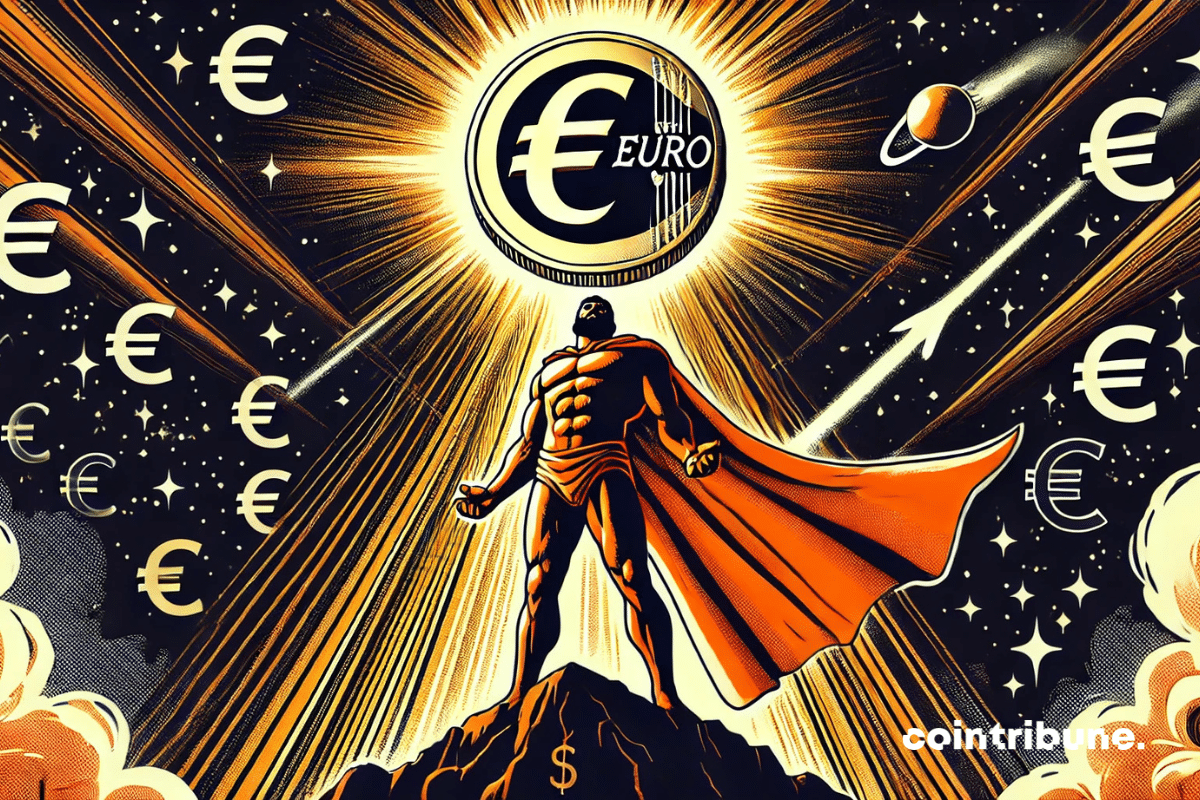The Trump administration has just triggered a real commercial earthquake. Through the imposition of a universal customs tax of 10%, soon raised to 34% for certain countries, Washington is reviving an aggressive protectionist strategy. This decision, counter to multilateral rules, threatens to reconfigure global trade and is already prompting reactions from more than 50 states. In a tense international context, this major shift could well mark the beginning of a new era of economic confrontation.
Getting informed
The FTX saga continues to shake the crypto ecosystem. Nearly 400,000 creditors of the now-bankrupt platform risk permanently losing their rights to refunds, estimated at over $2.5 billion. The cause: the failure to adhere to the mandatory identity verification process, the famous KYC (Know Your Customer).
The Ethereum network has reached a historic milestone with 200,000 addresses holding stablecoins. This record adoption stands as the backbone of a more mature digital economy, potentially reshuffling the cards for this altcoin whose price is struggling to take off.
While stock markets are experiencing a historic loss, Bitcoin is losing ground and has fallen below 80,000 dollars. This decline, far from being trivial, reignites the debate about its safe haven function. At a time when trade and political tensions are reshaping the global economy, the line between traditional assets and cryptocurrencies is blurring. A moment of truth is therefore approaching for BTC and for investors' allocation strategies.
The crypto market is experiencing one of its most violent crashes today. After resisting the Trump storm until now, it has finally given in! In just 60 minutes, over 200 million dollars have been liquidated, taking with them the hopes for a short-term rebound. As a result, the total market has fallen to 2.51 trillion dollars, showing a loss of more than 5% in less than 24 hours.
Numbers are plummeting, volumes are exploding, and institutional investors are quietly slipping away. Bitcoin ETFs may be entering this pivotal moment where silence speaks louder than words.
While instability dominates the crypto universe, Pi Network surprised everyone with a 50% surge in just 24 hours. This spectacular rebound, following a prolonged decline, rekindles interest in a project still seeking institutional recognition. However, behind the apparent enthusiasm, contradictory signals remain. Does this rebound mark the beginning of a solid recovery, or is it merely a temporary spike?
Meta has just unveiled Llama 4, its most advanced artificial intelligence model to date. According to David Sacks, AI advisor at the White House, this technological advancement restores the United States' edge in the global competition for supremacy in AI.
The crypto universe is anything but routine. This time, it's Conor McGregor, MMA icon and seasoned entrepreneur, shaking up the market with his memecoin "Real." Launched via a sealed auction—a first to avoid manipulation—this project combines crypto audacity with a formidable marketing strategy. Between revolutionary promises and analyst skepticism, "Real" raises a burning question: what if McGregor manages to change the game... for a fourth time?
When the crypto market succumbs to hype and spectacular narratives, fundamental signals get drowned out in the noise. However, it is precisely in these phases of disconnection between valuation and on-chain data that real dynamics take shape. Solana embodies this paradox today. Driven by metrics in sharp progression, yet underestimated by the market, the blockchain offers a very real potential that few seem willing to face.
Cryptocurrency is no longer a marginal experience. It is now embedded in the daily lives of millions of Americans, reshaping the contours of their financial autonomy. A recent study by the National Cryptocurrency Association reveals that 55 million adults hold digital assets. Among them, 76% believe that this technology has improved their quality of life. Far from clichés about speculation, these figures unveil a more nuanced reality: massive, pragmatic adoption, and a source of concrete hopes.
As Bitcoin strengthens its dominant position in the markets, the Kaiko Research report upends expectations for 2025: forget the widespread altseason of the past, only a few carefully selected altcoins will stand out this year.
As the American economy wobbles, Donald Trump secures a strategic victory in the Senate with the unlocking of a controversial budget. Behind this success lies a political clash with global repercussions. For both investors and crypto players, this vote opens an uncertain sequence that could redefine financial balances and impact the trajectory of markets.
While the crypto market seeks new breath after a dynamic start to the year, XRP is sinking into a bearish spiral. Ripple's asset has already lost more than 35% since its peak in January, and technical indicators point to a possible worsening. An unfavorable chart setup could lead to an additional drop of 25% this month. In this climate of uncertainty, XRP appears to be one of the most fragile assets at the moment, exposed to increasing selling pressure and disengagement from major investors.
Behind the overwhelming losses of SHIB wallets, the infrastructure still roars. Between discouragement and rumors of resurgence, the ecosystem slowly burns, ready to reignite the speculative flames.
Experienced traders continue to show interest in memecoins despite the obvious signs of exhaustion in the speculative market for these particular cryptocurrencies.
A historic day on Wall Street: on April 4, 2025, American markets lost $3.25 trillion, more than the total market capitalization of crypto. This brutal drop, triggered by tariff measures from Trump, reveals a deep crisis. Bitcoin, however, endures. An analysis of an economic shift.
In a geopolitical context undergoing a major reshuffle, two significant initiatives are shaking the hegemony of the dollar. Brazil and China are making a strategic shift by favoring their national currencies for bilateral exchanges. For their part, Russia and Iran are announcing the launch of a new common currency to circumvent Western sanctions. These distinct yet converging movements illustrate a shared desire among influential BRICS members: to build a financial system that is less dependent on the greenback and to assert monetary sovereignty in the face of external pressures.
The mysterious creator of Bitcoin, Satoshi Nakamoto, celebrates his 50th birthday today, as his innovation revolutionizes global finance and now attracts major economic powers.
Bitcoin shows a surprising resilience in the face of market collapse. While gold retreats, it rises alone toward $100,000, fueled by a breakthrough narrative.
The sudden calm that falls over a network as active as XRP is never trivial. After a stunning rally at the end of 2024, Ripple's blockchain is experiencing a plunge in its activity. This drop of 65% in just a few weeks is more than just a simple adjustment. It reveals a worrying loss of momentum and raises questions about the strength of the market. Behind the numbers, an entire speculative dynamic seems to be wavering.
Bitcoin may soon have to sacrifice some of its coins to survive the quantum era. In the face of the growing threat from quantum computers, a radical plan is on the table: to permanently burn thousands of bitcoins. This controversial project, called QRAMP ("Quantum-Resistant Address Migration Protocol"), proposes a hard fork to secure the network at the cost of a partial destruction of non-migrated BTC. The Bitcoin community must now choose between immediate security and absolute adherence to the original principles of cryptocurrency.
The sentiment for bitcoin is at its lowest since the beginning of 2023. However, several analysts are identifying encouraging signs of a possible change in momentum as the queen of cryptos shows remarkable resilience in the face of recent volatility in the US stock markets.
The billionaire Trump has transformed his setbacks into financial levers. Thanks to Truth Social and his crypto projects, he is multiplying his wealth by playing with expectations and speculations.
The famous video game franchise Fortnite has just integrated a replica of a Bitcoin mining farm into its latest update. This provocative reference has propelled the game-inspired memecoin "Dill Bits" to over 200%. A crypto nod that resonates beyond the virtual.
In an uncertain macroeconomic context, a clear trend is emerging: stablecoins are entering an independent bull market, according to the asset manager VanEck in its April 2025 report. While smart contract platforms like Solana and Ethereum are experiencing a significant slowdown, stablecoins are rapidly gaining ground in the crypto ecosystem.
The crypto market may soon experience a major new phase with the impending approval of Solana ETFs. For several years, investors have been seeking to diversify their crypto portfolios through regulated financial products. The introduction of ETFs based on assets like Bitcoin and Ethereum has already shown increasing interest. Today, Solana may well follow this trend.
In a global market in complete chaos, Warren Buffett stands out as an exception. While the richest fortunes are recording massive losses, the American investor makes 23.4 billion dollars in just a few months. This performance contrasts with the general trend and raises the question: how does the oracle of Omaha manage to thrive where so many others falter? At the head of Berkshire Hathaway, he once again demonstrates that discipline, foresight, and rigorous management can still dictate the rules, even in times of instability.
In a single session, the euro surged 2.15% against the dollar, reaching $1.109, its largest increase since 2015. This abrupt jump exceeds the mechanics of exchange rates. It signals a sudden loss of confidence in the American currency. Through this shift, markets appear to be reassessing the balance of power among major currencies, in a context where macroeconomic signals and central bank choices are redefining monetary fault lines.
In a single session, the euro surged 2.15% against the dollar, reaching $1.109, its largest increase since 2015. This sharp rebound goes beyond the mechanics of exchange rates. It signals a sudden loss of confidence in the American currency. Through this shift, markets seem to be reevaluating the balance of power between major currencies, in a context where macroeconomic signals and the choices of central banks are reshaping the lines of monetary fracture.




























